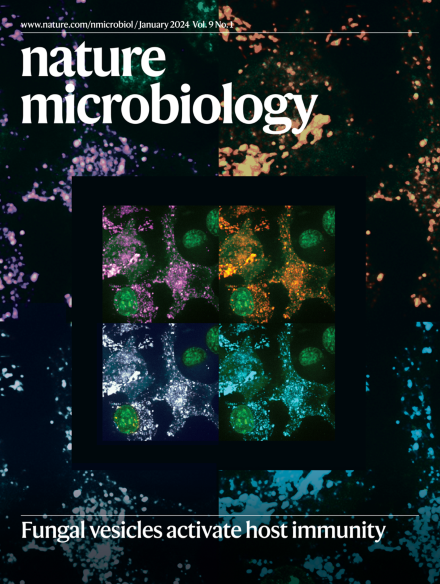Single-cell imaging of the Mycobacterium tuberculosis cell cycle reveals linear and heterogenous growth
IF 20.5
1区 生物学
Q1 MICROBIOLOGY
引用次数: 0
Abstract
Difficulties in antibiotic treatment of Mycobacterium tuberculosis (Mtb) are partly thought to be due to heterogeneity in growth. Although the ability of bacterial pathogens to regulate growth is crucial to control homeostasis, virulence and drug responses, single-cell growth and cell cycle behaviours of Mtb are poorly characterized. Here we use time-lapse, single-cell imaging of Mtb coupled with mathematical modelling to observe asymmetric growth and heterogeneity in cell size, interdivision time and elongation speed. We find that, contrary to Mycobacterium smegmatis, Mtb initiates cell growth not only from the old pole but also from new poles or both poles. Whereas most organisms grow exponentially at the single-cell level, Mtb has a linear growth mode. Our data show that the growth behaviour of Mtb diverges from that of model bacteria, provide details into how Mtb grows and creates heterogeneity and suggest that growth regulation may also diverge from that in other bacteria. Time-lapse imaging of Mycobacterium tuberculosis cells loaded in microfluidic chambers reveals heterogeneity in growth characteristics, atypical modes of polar growth initiation and linear growth at the single-cell level.


结核分枝杆菌细胞周期的单细胞成像揭示了线性和异质生长过程
抗生素治疗结核分枝杆菌(Mtb)的困难部分是由于生长的异质性。尽管细菌病原体调节生长的能力对于控制体内平衡、毒力和药物反应至关重要,但人们对 Mtb 的单细胞生长和细胞周期行为的描述还很不清楚。在这里,我们利用延时单细胞成像技术和数学建模技术来观察 Mtb 的不对称生长以及细胞大小、分裂间期和伸长速度的异质性。我们发现,与烟曲霉分枝杆菌相反,Mtb不仅从旧极开始细胞生长,也从新极或两极开始细胞生长。大多数生物在单细胞水平上呈指数增长,而 Mtb 则呈线性增长模式。我们的数据表明,Mtb的生长行为与模式细菌不同,提供了Mtb如何生长和产生异质性的细节,并表明生长调节也可能与其他细菌不同。
本文章由计算机程序翻译,如有差异,请以英文原文为准。
求助全文
约1分钟内获得全文
求助全文
来源期刊

Nature Microbiology
Immunology and Microbiology-Microbiology
CiteScore
44.40
自引率
1.10%
发文量
226
期刊介绍:
Nature Microbiology aims to cover a comprehensive range of topics related to microorganisms. This includes:
Evolution: The journal is interested in exploring the evolutionary aspects of microorganisms. This may include research on their genetic diversity, adaptation, and speciation over time.
Physiology and cell biology: Nature Microbiology seeks to understand the functions and characteristics of microorganisms at the cellular and physiological levels. This may involve studying their metabolism, growth patterns, and cellular processes.
Interactions: The journal focuses on the interactions microorganisms have with each other, as well as their interactions with hosts or the environment. This encompasses investigations into microbial communities, symbiotic relationships, and microbial responses to different environments.
Societal significance: Nature Microbiology recognizes the societal impact of microorganisms and welcomes studies that explore their practical applications. This may include research on microbial diseases, biotechnology, or environmental remediation.
In summary, Nature Microbiology is interested in research related to the evolution, physiology and cell biology of microorganisms, their interactions, and their societal relevance.
 求助内容:
求助内容: 应助结果提醒方式:
应助结果提醒方式:


